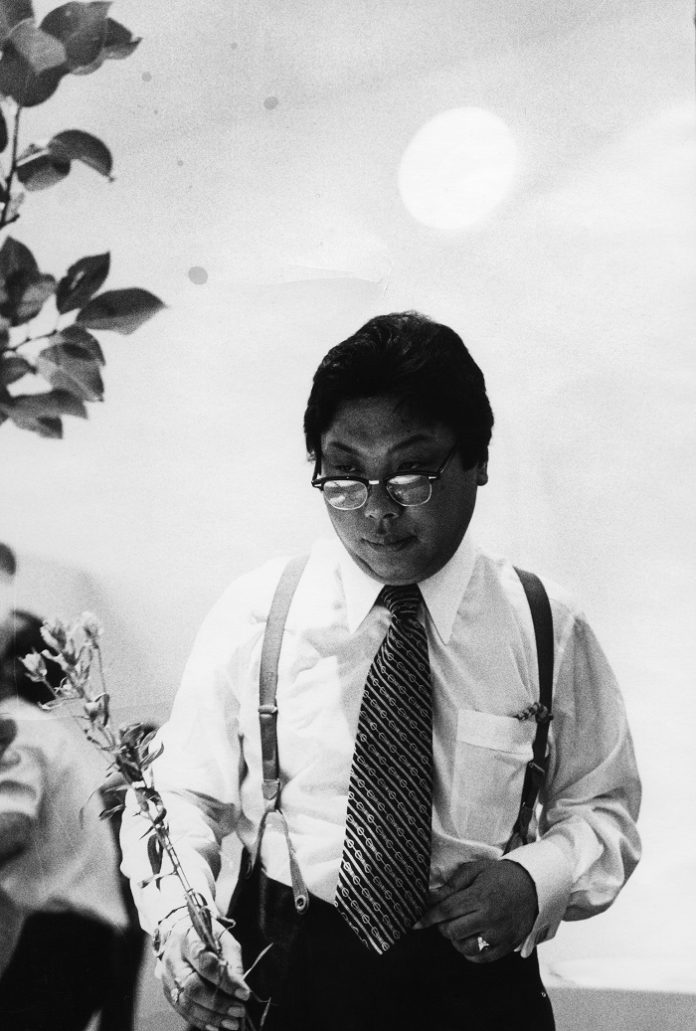
During his lifetime, the Vidyadhara took an active role in design. I believe his personal involvement with design was due in part to the great joy he derived from the arts—he loved to design—and because of the essential message the arts hold. “The path is the goal”—it is not just what we do, but how we do it—the art of life, and life as art, grace, enjoyment. The Vidyadhara paid as much attention to his dinner venue as he did to deciding how his organization should be governed.
His direct hand in design springs also from the significance he gave to this activity as direct dharma teaching—an emanation of the guru’s mind. His designs are not conventional, and they are not optional. They are not an adjunct to dharma—as in, if we have a little extra money, let’s make a nice poster, or add a dot and a line. They are dharma, and they are also the way dharma is communicated. They are the quintessential, primal language of sacred world. Waking up enlightened, they are the first grunts of awake. We call them seed syllables, sign language, because these signs and symbols are the seeds out of which a vajra world is born. The Vidyadhara’s designs carry transmission, communicating directly to our pre-thought level. In our ancient days, people would sometimes come to a dharma talk without any previous interest in the teachings, just because they had seen a poster. Perhaps the image ignited some kind of karmic connection, or just communicated in an immediate, personal way.
The Vidyadhara was also not just making stuff: he was creating a world. He once said that enlightened society is an environment that nurtures the waking state of mind of the student warrior. If you can capture the perception of awake mind in physical space, physical places and spaces can hold and carry transmission and ignite awakening. He was embodying such a pervasive environment, where sacredness has no gaps. We call this pervasive container Shambhala Culture. Culture is the most important upaya, or method in the Shambhala approach, because it brings transformation on a large scale, uplifting or degrading an entire people. The Vidyadhara’s ultimate design was a cohesive, transforming, revolutionary culture built on the foundation of intrinsic goodness, arising from the meditative state. He called the spiritual power of innate goodness drala. The Shambhalian culture he was creating was a drala culture, imbued with spiritual presence, illuminating a path.
Shambhala is the coemergence of spiritual and temporal—uncovering sacredness within daily life. Without a temporal manifestation in a real world, it is not Shambhala, but rather, theory or myth. The Vidyadhara’s design work embodies sacredness in and through the physical realm, converting it. At the same time, the designs and objects he created are non-material in the materialistic sense. They carry and collect power, and link us beyond the material to the magical, energetic realm. According to the Vidyadhara: “If the warrior has no sword, the blessings of the dralas cannot be gathered.” Without a physical container, power dissipates: temporal, physical embodiment is required to gather, accumulate, stabilize, wield and sustain spiritual energy.
The Vidyadhara set about designing a world, not by introducing something foreign, but by literally turning our conventional world inside out, revealing essence. He took any and every manifestation he encountered and turned it upside down, his ‘great switcheroo’, exposing its wisdom underbelly. He designed heraldry, standards, pins, uniforms, jewelry, ikebana, furniture, buildings, dinner parties, calligraphy, brocades, banners, posters, logos, ties, tiaras, cufflinks; and also, ceremonies, events, institutions, organizations, government, societies, and us. He was flipping our conventional perception and the mundane reality we inhabit into a luminous, impregnated, electric environment of GES: Great Eastern Sun—enlightened society.
Within any and every situation power and virtue can be revealed. The first trick is to see it—the perception of the artist. Having seen, the job is cultivation: culture is the manual practice of drawing out that essence. The Vidyadhara called this cultivation elegantizing—the essential practice of dharma art. Elegance is the beauty and power that arises when the hidden virtue in things is brought to maturity. Like enlightened nature, existing within us as a seed, such virtue must be cultivated to ripening. Cultivation, elegantizing, is the method by which drala is distilled, purified and strengthened, like the polishing of a rough diamond to allow it to radiate.
The Vidyadhara said “discovering elegance is the way of the warrior”. Not just the way of the artist—the way of the warrior, which includes all of us. It is what we do in a warrior culture—our livelihood. We cultivate basic goodness by uncovering it in people, environments, and events.
The Vidyadhara called the embodied environment of sacredness the outer court. A court, in our Shambhala tradition, is a sacred dwelling place; the outer court refers to dwelling in an outer or physical container saturated with goodness. The vivid manifestation of the outer court is essential to the Shambhala path. It is a transmission environment of awake. The outer court captures alive the transcendent energy of the drala world and makes it available to our senses. Like our living teacher, this is the final confirmation that the sacred world is real beyond theory or doubt: we can glimpse it, smell it. The outer court transforms our inner landscape. In the Buddhist path, we go from inside out, manifesting in a vajra kingdom at dharma’s peak. In Shambhala, we often go the other way, from manifestation to the un-manifested—the world of empowered form is the trigger, setting us on the path.
Dharma art is the outer court—the embodiment of sacredness. It is also the training on how to create it. The dharma art teachings offer instruction on how to see the sacred world, recognize its innate pattern, and apply those patterns in design so that we can literally, manually, bring the potential for sacred world into physical embodiment. When we organize in this way, the conduit between heaven, earth and humanity opens and energy and magic arise. The Vidyadhara created very simple exercises that teach us how to design in the way that he practiced. One important exercise, object arranging, is to design what shamatha is to advanced practice: it is both the foundation and the essence. This simple exercise teaches how to design according to the pattern language of the sacred world, and in so doing, to capture its energy and spiritual power. When these patterns are mirrored in the organization of our world, we can attune to the same enlightened pattern latent within us.
On this twentieth anniversary of the Vidyadhara’s Parinirvana, we contemplate his immeasurable legacy and what we can do to preserve it. Legacy is about preserving this precious inheritance for the benefit of future generations. It is also about continuing what he taught as a living legacy—living the legacy. We can honor his life by following his example. Living the way he lived. Practicing as he practiced. And continuing to design the way he designed, for the reasons he designed, to give birth to a living and vital culture. We can do that. We have to do that to continue his work and vision. The Vidyadhara said, “Words don’t cook rice”. Let’s cook some rice. As he said, “Just do it.”
















